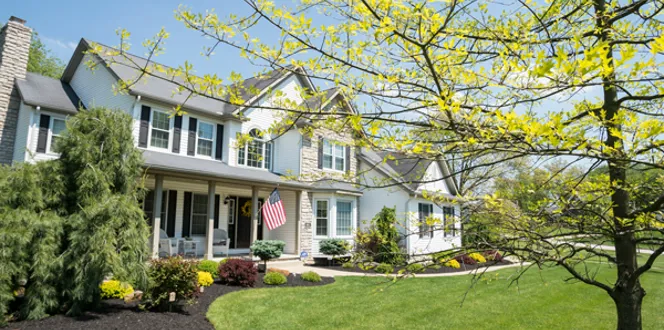Spending quality time with our trees often gives us a warm feeling— and it’s not just on the inside.
One of the many ways trees work hard to keep us happy is by warming our landscapes in winter. Rows of wind-blocking trees reduce wind and may help heat up your home.
The best windbreaks take time and planning, but they pay us back in cozy comfort. Read on to find out the best windbreak trees for your area and tips on how to plant them.
Planting Trees For Energy Efficiency
Windbreaks don’t just warm us up in winter. All year, they keep our yards at a steady temperature, lowering heating and cooling costs for our home. To maximize the benefits, plant the right tree in the right place.
What Side Of The House To Plant Landscape Windbreaks
Before you start planting, it’s important to map out your yard. Plant windbreaks on the north and northwest sides of your home where it gets coolest in the winter.
Windbreak Tree Spacing
It might seem like planting trees close is the best way to keep the wind out. But tightly packed trees will become a problem once they mature. The more space you put between trees in the beginning, the longer your windbreaker does its job.
- If you’re planting rows of shorter trees, leave about 10 feet of space between each tree and 15-to-20 feet between each row.
- If you’re planting rows of taller trees, leave 15 feet between each tree and 25 feet of space between rows.
- Remember as these trees grow the space, they’ll fill in that space.
Best Wind-Blocking Trees: Zone 7, Zone 8, Zone 9 & Zone 10
Set yourself up for success by picking trees in your planting zone.
- Eastern redcedar (zones 2-9): An evergreen that grows about 50 feet tall and loves direct sunlight
- Chinese juniper (zones 4-9): A durable evergreen that’s resistant to deer browsing
- Port Orford cedar (zones 6-10): A fast-growing evergreen that’s native to Oregon
Best Wind-Blocking Trees: Zone 3, Zone 4, Zone 5 & Zone 6
Remember to pick trees suited for your planting zone.
- Norway spruce (zones 3-7): A strong, fast-growing evergreen that tolerates various soils
- Green giant arborvitae (zones 5-7): A fast-growing evergreen with a classic pyramid shape
- Eastern white pine (zone 3-6): A conifer that grows up to three feet per year
- Colorado blue spruce (zones 3-6): An evergreen with unique color
- White cedar (zones 3-7): A popular conifer with a long cone shape
- Douglas fir (zones 4-6): A sturdy tree that's perfect for snowy and icy climates
- White fir (zones 4-7): A short evergreen commonly used as a Christmas tree
- Rocky Mountain Juniper (zones 4-9): A hardy tree that is a good replacement for Eastern Redcedar when conditions are too dry.
When you pick your plants, remember to mix. If you plant rows of the same tree, you can risk losing your windbreak to a single pest or disease. Alternate between two or three tree types to keep your windbreak up and running.
As the windbreak is getting started, it may be beneficial to include a row of shrubs to help block the wind. These will fill in gaps until the trees begin to mature and add diversity and color to the windbreak as well.







